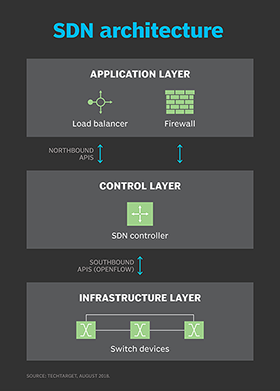SDN controller (software-defined networking controller)
What is an SDN controller?
A software-defined networking controller is an application in SDN architecture that manages Flow control for improved network management and application performance. The SDN controller platform typically runs on a server and uses protocols to tell switches where to send packets.
SDN controllers direct traffic according to forwarding policies that a network operator puts in place, thereby minimizing manual configurations for individual network devices.
The centralized controller takes the control plane off the network hardware and running it as software instead. This capability facilitates automated network management and makes it easier to integrate and administer business applications. In effect, the SDN controller serves as a sort of operating system (OS) for the network.
The controller is the core of a software-defined network. It resides between network devices at one end of the network and applications at the other end. Any communication between applications and network devices must go through the controller.
Controller APIs
The controller communicates with applications -- such as firewalls or load balancers -- via northbound interfaces. The Open Networking Foundation (ONF) created a working group in 2013 focused specifically on northbound APIs and their development. The industry never settled on a standardized set, however, largely because application requirements vary so widely.
The controller talks with individual network devices using a southbound interface, traditionally one like the OpenFlow protocol. These southbound APIs enable the controller to configure network devices and choose the optimal network path for application traffic. OpenFlow was created by ONF in 2011.

Pros and cons of SDN controllers
One major benefit of SDN controllers is the centralized controller is aware of all available network paths and can direct packets based on traffic requirements. Because of the controller's visibility into the network, it can automatically modify traffic flows and notify network administrators about congested links.
Companies can use more than one controller, adding a backup for redundancy. It's common for both commercial and open source SDN options to use three controllers. This redundancy enables the network to continue running in the event of lost connectivity or controller susceptibility.
The controller acts as a single point of failure, so securing it is pivotal to any software-defined network. Whoever owns the controller has access to the entire network. This means network admins should create security and authentication policies to ensure only the right people have access.
SDN controller vendors
Vendors that offer SDN controllers include the following:
- Cisco.
- Hewlett Packard Enterprise.
- Juniper Networks.
- NEC.
- Nuage Networks.
- Nvidia.
- Pica8.
- VMware.
Open source SDN controllers
SDN controllers are also available as open source options, including the following:
- NOX/POX.
- OpenDaylight.
- Open Network Operating System.
- Tungsten Fabric.
SD-WAN controllers
Traditionally, SDN controllers are used in data center networks. As SDN technology evolved, however, the WAN became a compelling use case, driving the growth of software-defined WAN (SD-WAN) technology.
An SD-WAN controller performs many of the same duties as an SDN controller, following policy configurations to direct WAN traffic over the most efficient route. The SD-WAN market has fewer notable open source options than SDN, as most SD-WAN controllers typically come tied together with the vendor's proprietary SD-WAN platform.
Editor's note: This definition was updated to reflect changes in controller options and to improve the reader experience.







